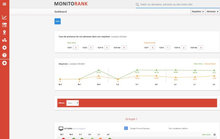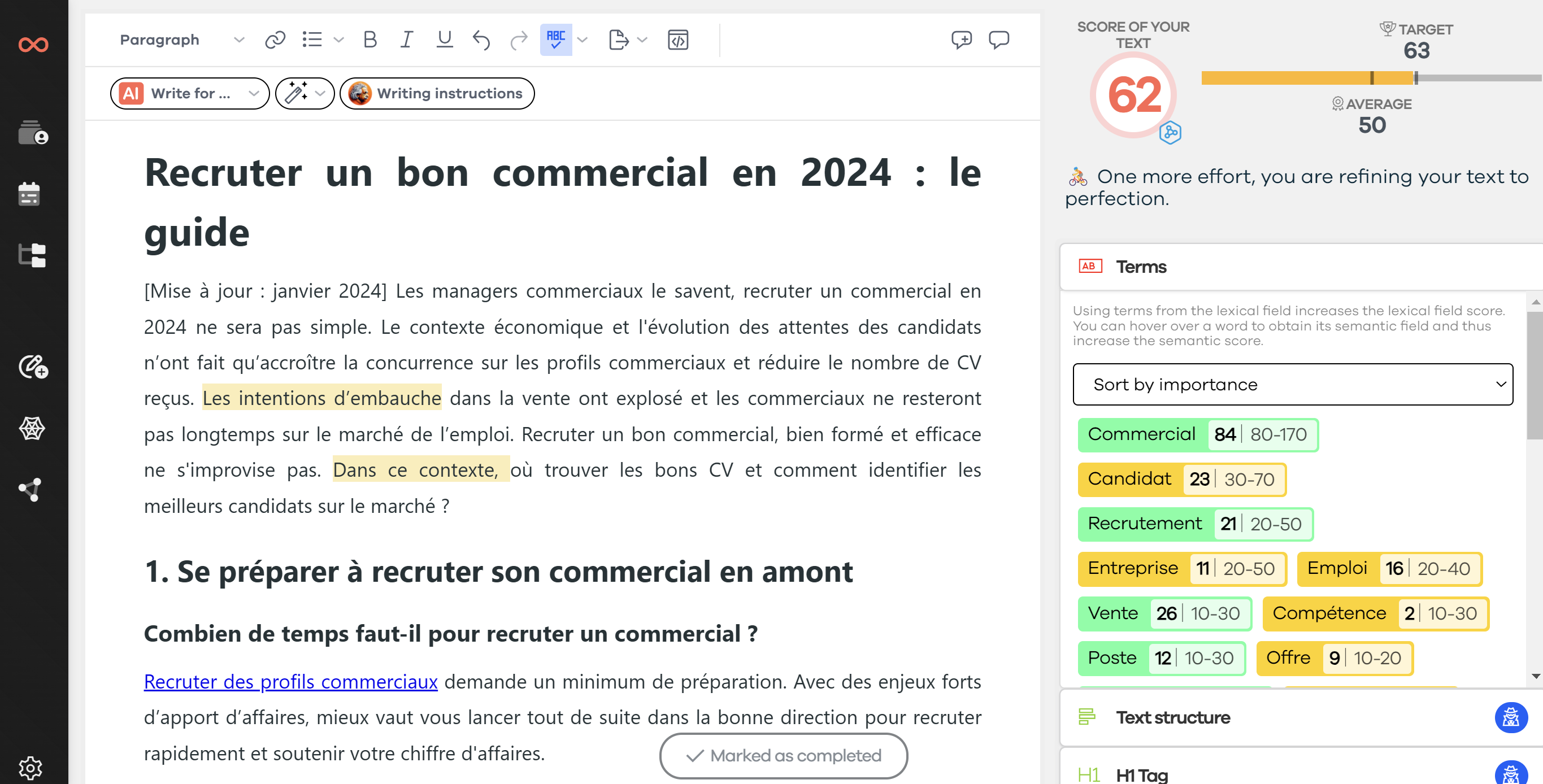Natural SEO is a very powerful lever, but it requires time and often a significant cost for a website owner. Moreover, far too many SEO specialists are content with tracking rankings to demonstrate the success of the actions implemented. But more often than not, this is not what their clients want!
In reality, what they want is to achieve a positive return on investment (ROI) on their SEO campaign. So, to truly satisfy their client, the SEO expert must first know their economic objectives before being able to define the actions to be taken and the key performance indicators (KPI) to monitor.
To make this concept frequently overlooked by natural SEO consultants more accessible, we invite you to discover the concrete case of two websites with different commercial goals. You will thus discover the solutions that should have been implemented to ensure good results for the SEO campaigns carried out.
There are so many different cases that it would be impossible to detail them all. However, these SEO campaign examples will help you understand the general logic. You will then be able to:
- implement the most suitable strategy for your needs;
- define the right KPIs to measure its results.
🚀 Quick read: summary of what you will discover in this article
Today, we will look at the following hypothesis. Arthur, the project manager of an SEO agency, has recently concluded two new SEO contracts with very different clients:
- Service Gaz Plus, a specialized company in storage and distribution of all gases, which wants to increase leads through its blog.
- The law firm "Parole d'avocat", a local firm that wants to attract businesses that live in the region.
Both campaigns will need to be customized to adapt to the respective objectives of each company. First and foremost, Arthur must seek to understand the clients' business objectives and how they will influence the SEO strategy.
He can then focus on the technical details:
- setting up the editorial strategy,
- finding keywords,
- specifying content calendars,
- optimizing SEO hotspots,
- etc.

Finally, you will find a brief summary of the key steps of an SEO campaign and the most commonly used indicators to measure its success.
🏆 Success: the accomplishment of a goal or objective
It is essential to agree on the success criteria. Most of the time, the ranking of the website on one or more key phrases is chosen as the main performance indicator. And there's nothing wrong with that! It is, in fact, one of the most tried and tested measures in the SEO field, and any campaign that ignores keyword rankings is incomplete.
That being said, keyword rankings are not always the most relevant indicator.
What you and your client consider as proof of the "success" of the strategy depends on the result of a variety of factors. Each client has different business objectives that will affect the key performance indicators (KPIs) you will need to monitor. Does the client want to:
- Increase sales or drive a specific action on their site (such as newsletter sign-up, downloading a white paper, etc.)?
- Boost brand visibility at the local level?
- Become a national brand?
- Improve the usability of their website?
Of course, a tailored SEO campaign should bring improvements in each of these areas. However, to maximize its effectiveness, you must choose the right performance indicator.
🤝 Sometimes, the conversion rate matters more than the site's positioning
1. Hypothesis
Service Gaz Plus is a company specializing in fluid transport, particularly gas. The client recently watched a YouTube video explaining how blogs can generate more revenue. They are now determined to reach the first position on Google.
The company's blog focuses on new accessories in the sector and gas industry technology (vaporizer, solenoid valve...). It is already ranked on the first page (TOP 10) for many terms related to the field. However, the website struggles to get new leads.
Arthur is convinced that with some optimization on the page, the site can make it into the top 3. He sets up a monthly ranking tracking report with a tool (Monitorank, YoodaInsight, ...) and makes some optimizations.
2. The problem
Three months later... The site appears in the first position for a handful of targeted keywords, and the keyword ranking tracking reports are encouraging. However, lead growth remains low. The client sends numerous emails to Arthur, asking why the number of clients has not increased.
3. The solution
Could Arthur have prevented this delicate situation? First, Arthur could have set appropriate expectations at the beginning of the campaign. Some clients have difficulty understanding how SEO works, so it is not surprising that clients tend to consider ranking as the sole criterion for success.
Translating the client's needs into an actionable strategy that will improve the company's revenue is part of your responsibilities. If the client's expectations are misguided, you must guide them in the right direction.
Arthur chose keyword ranking as an indicator and gave the client false hopes. Page optimization allowed the site to be ranked in the first position but had no impact on leads. Since the client's main goal was to increase leads, conversion tracking would have been a much more suitable tool for evaluating the success of the campaign.
For example, if Arthur had set up Google Analytics to count new form submissions or installed a lead tracking tool, he would be able to provide information about the client's primary goal.
👁️🗨️ Understanding when visibility is important
1. Hypothesis
Parole d'avocat is a local law firm. It has been providing legal services to clients in their city for many years.
However, demand has recently decreased. The client hopes to attract clients from neighboring cities and the region.
They are adamant: the site must appear in searches mentioning the nearest major city, even if it is about 100 km away from the firm.
Arthur agrees to build new SEO pages and try to make the site visible in the region's major cities since that is the client's stated goal.
2. The problem
Three months later... Although Arthur did his best, he failed to rank the site in the region's major cities. The client begins to wonder if it would be better to spend their marketing budget differently, such as buying print ads in magazines since they know these have worked in the past.
In this example, Arthur's approach was incorrect from the start. Even though the client explicitly stated that their main goal is to be ranked in the region's major cities, their underlying goal is to expand their clientele. Successfully ranking a law firm's site in cities 100 km away is a daunting (if not impossible) task. Thank you, Google!
3. The solution
Helping a business increase its average monthly organic traffic (middle of the tail) is much less difficult and just as useful. Combine this with a targeted SEA acquisition strategy (work your network) focused on major cities, and you're done. It is your responsibility as an SEO specialist to explain this to your client.
By focusing on keyword ranking, Arthur limited his discourse. Keywords alone do not provide a clear picture of the situation. It would have been wise to monitor incoming traffic to the site by acquisition channels using Google Analytics. Arthur could then segment traffic data to know the audience's location. A more targeted approach combined with:
- an SEO strategy focused on neighboring small towns
- an SEA strategy on the region's major cities
Implementing these actions would likely have satisfied the client more!
🗝️ The steps of an SEO campaign
As you have understood, first and foremost, you must understand your client's objectives! Of course, similar actions must always be implemented, especially regarding the 3 pillars of SEO:
- content,
- technical
- popularity.
But if we take the example of content, you certainly know that its quality is essential. However, depending on your client's needs, quality is again ambiguous. If you want to sell a product, encourage downloading an e-book, or entice signing up for a newsletter, the "quality" of your content is not the same!
Thus, the steps to follow are:
- define the client's objectives;
- find the most suitable solutions to achieve them;
- set up the most appropriate KPIs to check the success of the SEO campaign.
Because rest assured, you cannot have a single SEO campaign model and offer it as is to your clients! This is precisely what makes the SEO profession so interesting and appealing...
📊 Which KPIs to use to measure the results of an SEO campaign?
As we have just seen, performance indicators are not all the same. They are closely linked to the objectives your client wants to achieve. Thus, during the first interview, think about defining them precisely and make sure they are truly measurable.
You can then take care of implementing the most suitable strategy and defining the performance indicators that best match. To help you, we offer below a non-exhaustive list of indicators to monitor.
Also, remember that to quickly achieve these objectives and maintain them in the long term, a good SEO campaign must be built on solid foundations. That's why a complete SEO audit is necessary before embarking on creating an SEO strategy.
Engagement measures
All these parameters can be set in Google Analytics!
- Conversion rate (number of conversions divided by the number of visitors)
- Time spent on a specific page (to be compared to the content length for a coherent result)
- Pages per visitor (important if the goal of a page is to convert and redirect to another page)
- Bounce rate (although this indicator is not the most important, it can be useful depending on the objective to be achieved)
- Scroll depth
- Etc.
Audience-related measures
This information is also available on Google Analytics.
- Traffic channels: allows isolating a specific channel (SEO, SEA, social networks, etc.),
- Geographic data: to perfectly geolocate your readership
- Demographic data: does it match the client's avatar?
- etc.
Traffic and positioning measurement on search engines
Traffic and positioning information on Google is available on tracking tools such as SemRush, Ranxplorer, or Search Console.
- Organic traffic evolution: overall evolution and seasonality comparison are good indicators.
- Number of keywords on the first 3 pages of Google: allows knowing the evolution and improvement potential.
- SERP ranking evolution: to be compared with the client's main objectives.
- etc.
Other factors to measure an SEO campaign
- Click-through rate (visible on Search Console): maybe the Title or meta description can be improved?
- Semantic score of a page (with our semantic tool): the page is consistent with the rest of the site and sufficiently linked to others (internal linking).
- Number of backlinks (for example with Majestic or Ahrefs): allows, in particular, to control the quality of each link.
- Site popularity (for example with Majestic or Ahrefs): to know the success of the link building strategy.
- Etc.
Success is relative! What defines the success of one SEO campaign is not necessarily synonymous with success for another. Better ranking does not always mean success. It is therefore crucial to know how to choose your KPIs well.
As an SEO professional, you must understand your client's business objectives in order to choose the right key performance indicators.
Your job is to use data to tell a story that takes into account your client's objectives. The fate of each campaign depends on your ability to choose the right performance indicators and simply explain their meaning.
Need to go further?
If you need to delve deeper into the topic, the editorial team recommends the following 5 contents:


